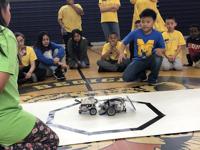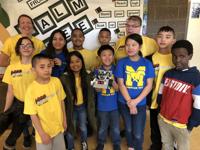[ad_1]
It just wasn’t starting out too well for Kaiser Lee.
He was, by choice, at school on a Saturday morning preparing for a robot Olympics. But his robot was not working properly.
He was frustrated. Everything had been fine on Thursday when the fifth grade student at Mt. View Elementary had tested the robot’s programming.
But Saturday morning as his team, the Mt. View Mustangs, were preparing to board the school bus for a road trip to Begich Middle School, the “bot” as students affectionately refer to the various contraptions made from Lego materials, just wasn’t working.
“I thought about just leaving it behind,” Lee admitted.
Lee and team members fiercely worked in the pits of the Begich lunch room hoping against hope that they could fix whatever was wrong before their event began in a couple hours.
They applied some perseverance and the team was able to get the robot named “KRAPPED” working said their coach, Brittany Hanson. She was quick to point out that the robot’s name is derived from the first name initials of team members. She smiled that knowing smile that the team members are after all kids in elementary school. The robot’s name also sparked a few chuckles from the gathered crowd every time it was announced by officials running the SumoBot competition.
That’s why Lee and his teammates were pretty glad they decided to keep working on KRAPPED’s dysfunction that Saturday morning rather than leave their pride and joy behind.
KRAPPED was indeed the clear-cut winner of the SumoBot competition pushing every other robot out of the circle in which opposing players were placed with ease.
And from the smiles on their faces, the members of the Mt. View Mustangs robot team were clear winners in more than just the competition.
Lee readily admits that the after-school program, which is run through the Anchorage School District’s 21st Century Community Learning Center division, is what keeps him coming back to school.
That’s good news to Marcy Richards, who manages the sites at nine of the district’s most disadvantaged schools.
The idea of combining after-school programs with Lego robot technology is finishing up its first year in the ASD.
It’s a groundbreaking concept that Richards believes can serve as a national model.
In most academic settings, it is the “smarter” kids that work with robotics during the regular school day while academically challenged students work on remedial tasks. That is still happening during the school day at the nine ASD elementary schools where a 21st Century after school program exists. The robotics program is a side benefit of the after school program.
The idea of putting the focus on having struggling students – students with academic deficiencies, students with behavioral challenges, kids that come from some of the municipality’s toughest neighborhoods – in an after-school program as the primary users of the robotics is pretty much a new concept.

But for Richards it makes perfect sense.
“These are the kids that need something to look forward to after school,” she said. “They have to attend class during the day to be eligible to do the after school program. For some of them, the opportunity to work with the robots is what keeps them engaged during the school day.”
Richards received a grant from the LEGO Foundation to supply all the necessary items from robots to computer software to set up a robotics program.
The after-school students worked this entire school year to design and perfect the movement of robots to do a variety of tasks. Some robots battle each other; some robots pull weights; some robots navigate an obstacle course and retrieve items.
The task itself matters, but isn’t nearly as important as the life lessons Richards sees the students experiencing.
“They are learning to work together as a team and they are also learning that they are capable of achieving,” Richards said.

It’s a win-win for the regular school day and the after school program.
So, as school winds down for the 2018-19 school year, Richards packs up the robots and associated supplies.
They await another school year beginning in mid-August.
There will be an additional factor for the coming school year.
Richards will have some data on how the students performed with the robots. She hopes her data collection this past school year documents after school students making school day academic improvement.
If nothing else, she knows the students in the after school program have made skill-affirming memories.
“Our team did it,” Lee said. The grin on his face spread from ear to ear. “We did this together.”
[ad_2]
Source link





Leave A Comment
You must be logged in to post a comment.